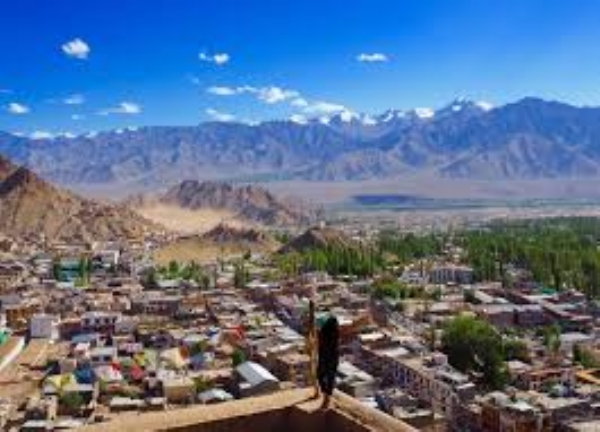Building the highest-altitude university in the world in sindhu valley
11 Aug 2021 10:57:06
India is a nature venerating civilization. But since the establishment of modern universities in the 1850s in India, colonial citadels hindered this civilizational sentiment. Now with India coming into its own, such illicit citadels are collapsing.

In the recent 2021 monsoon session of the Lok Sabha, the Indian government has tabled a bill for establishing the Sindhu Central University in Ladakh. Although not much is known about the university, it is demonstrating extraordinary traits before its inception.
The decision to name it after the mighty Sindhu River, which flows through Ladakh, is highly symbolic. It will be India's first university synchronizing our civilizational reverence for nature. At an altitude of around 3500 meters, the SCU will likely become the highest university in the world. The SCU has a lot running for it if its administrators are to fully extract the immense potential of being situated in the strategic locales of Ladakh.
Indian universities are not known to utilize the geographical advantages of their locales. If that had been so, the universities in Mumbai and Chennai would have had flourishing marine and maritime sciences capacities. The University of Delhi and Prayag would have cleaned up the Yamuna. While the Indian Institutes of Technology flourished with a firm brand name, many central and state universities remained entangled in the archaic departmentalization of research into chemical, biological, physical, and mathematical sciences. Many of these central and state universities often work as external appendages of the state-run scientific research institutions of ICAR, CSIR, DAE, DoS, DRDO, MEITY, many having independent campuses. The archaic segregation of departments and the absence of such R&D institutions within their campuses have effectually kept our state and central universities at abysmally low global rankings. The Sindhu Central University has the potential to change that.
In a world conscious of climate change, it will be interesting to know only a handful of regions, Taklamakan, Gobi, Atacama, Qyzylqum, Great Basin, Patagonia, and Ladakh, are classified as 'cold desert climates.' Ladakh has the highest altitude among them. It, therefore, can offer an unparalleled geographical advantage to SCU's research and academic initiatives.
Ladakh is on the strategic junction, amid the Hindukush, Karakoram, and Himalayan Ranges close to the Earth's Third Pole and the numerous glaciers that feed rivers of South Asia. By taking advantage of its proximity to the Third Pole, the SCU can cultivate world-class research competence in high-altitude ecology, geology, climate, and atmospheric studies. It can accomplish this by nurturing strong synergies with the Ministry of Earth Sciences, the Department of Science and Technology, and the Ministry of Environment and Forests and Climate Change.
Being a high-altitude desert, Ladakh experiences high solar flux and dry weather. These facets can prove vital for SCU to develop cutting-edge research competencies in high-altitude sensors, electronics, optics, communications, solar power, aerospace engineering, semiconductors, optoelectronics, and similar niche hardware-associated domains.
Ladakh is second to none as a proving ground for astronomy. A 'dark-sky reserve' – geography devoid of air or light pollution fit for astronomy – close by its campus can make the SCU a mega-hub of high-tech astronomy and allied instrumentation. Again, the university may accommodate independent laboratories with collateral investments from the Department of Space, Atomic Energy, the Ministry of Science and Technology, and Electronics and Information Technology.
The SCU can also become a hub of high-altitude health science research. The research will have immense applications for astronaut athletes and mountaineer training, aerospace, space medicine, cosmic radiation's impact on human health, space station training, and many other related fields. Here too, the Defence Research and Development Organization, Indian Space Research Organization, Ministry of Health and Family Welfare, Ministry of Youth Affairs and Sports, and other agencies can become vital stakeholders.
On the culture, history, and archeology front, Ladakh is a gateway to the cultures and civilizations of Central Asia. The university can house research on ancient and potential trading routes, explore the expanse of Indic cultures and identify commonalities with the customs of Central Asian cultures, determine the impact of climate change on communities and their agglomerations, and that of sustainable and environmentally-friendly economic growth in the Roof of the World. The ministries of Culture, External Affairs, Commerce and Industry, Micro-, Small and Medium Enterprises can play a crucial role in upkeeping the humanities and management research.
Providing accessible quality education to the masses has always been a priority of setting up new universities in India. Often such decisions were taken with populous electoral goals in sight. But that has never helped fully. Instead, India should shape its universities with a singular goal of attaining global top domain ranks by utilizing the advantages of our country's great geographical, cultural, climatic, and biological diversity. The Sindhu Central University may prove to be the spark to throttle Indian universities to high global rankings. SCU's administrators, please note.
.
.